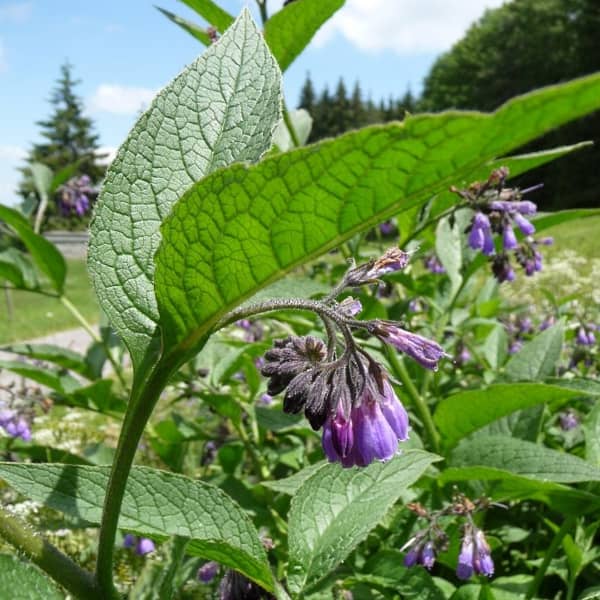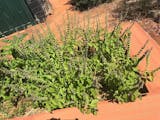Comfrey is an ancient perennial tea, fertilizer and medicinal plant that has been known since ancient times and is widespread in Europe, North Africa and Western and Central Asia. The species occurs wild in Europe, mainly in moist locations such as meadows, stream edges and ditches. The strong and resilient perennial develops crimson to light purple flowers that make excellent bee pasture. The strong runner-forming rhizomes are used as medicine and help externally to heal wounds and to relieve bone fractures, tendonitis and swelling. Manure from the plant is an excellent nitrogen, phosphorus and potassium fertilizer and strengthens the resistance of plants to pests and fungal diseases.
General information
Plant family: Boraginaceae
Life cycle: Perennial
Days to harvest: 100 days
Plant height approx.: 100 cm
Root type: Deep rooter, runner forming
Nutrient requirements: Medium eater
Water requirements: Medium
Winter hardiness: Up to -30 °C
Location: Sunny until semi shady
Soil: Permeable, moist, moist, slightly loamy, humus
pH value: 6.5 to 7.5
Sowing and planting information
Germ type: Dark and cold germinator
Sowing depth: 1 cm
Optimal germination temperature: 3-5 °C
Germination time: 20-30 days
Plant and row spacing: 50x50 cm
Optimal mixed culture:
Unfavorable mixed culture:
Subtropic climate (Mediterranean) (e. g. B. Portugal, Spain, Italy)
Sow directly outdoors from November to January or pre-cultivate in small pots from January to April with artificial stratification.
Moderate climate (e. g. B. Germany, Switzerland, Poland)
Sow directly outdoors from March to May or in autumn from October to November or pre-cultivate in small pots from February to May or in autumn from September to November.
General
The germination of the seeds is naturally irregular and requires exposure to cold at 0°C for 5-6 weeks. Alternatively, artificial stratification in the refrigerator is possible. Sow directly in rows. When pre-cultivating, sow the seeds in small pots and let the seedlings grow to the first visible comfrey leaves. Then plant the pregrown plants from the pots directly into the open field. The seedlings are planted in the bed from the 2nd pair of leaves after the cotyledons.
Comfrey prefers a sunny to partially shaded location with moist, well-drained, humus-rich and sandy loam soil. Prepare the soil with seasoned animal manure. Avoid waterlogging.
Additional tips
A partially shaded location is advisable if there is little water supply. In full sun it only thrives on extremely moist to wet soils. In order to quickly obtain a fine, crumbly and permeable soil, we recommend additional incorporation of biochar and primary rock powder.
Type of propagation
It spreads via seeds or through root division.
Plant care
After the first frosts in late autumn, it is advisable to prune the plant so that it sprouts more vigorously next year and prevents uncontrolled spread by seeds. Regular watering results in more stable growth. Beds prepared with animal manure and planting in mixed culture replace additional fertilizer.
Germination ability of seeds: 1-2 years
Other Names
Botanical names: Symphytum officinale
English names: Comfrey, Common comfrey, True comfrey
German names: Beinwell, Beinheil, Beinwurz, Echter Beinwell, Bienenkraut, Wundallheil, Eselohrwurz, Milchwurz, Schadheilwurz, Wallwurz
Portuguese names: Confrei, Consolda
Spanish names: Consuelda
French names: Consoude, Confée, la consoude



![Comfrey [Symphytum officinale]](http://www.benjis.net/cdn/shop/files/Beinwell-Comfrey-Confrei-Symphytumofficinale-www.benjis.net.jpg?v=1710463504&width=1445)





